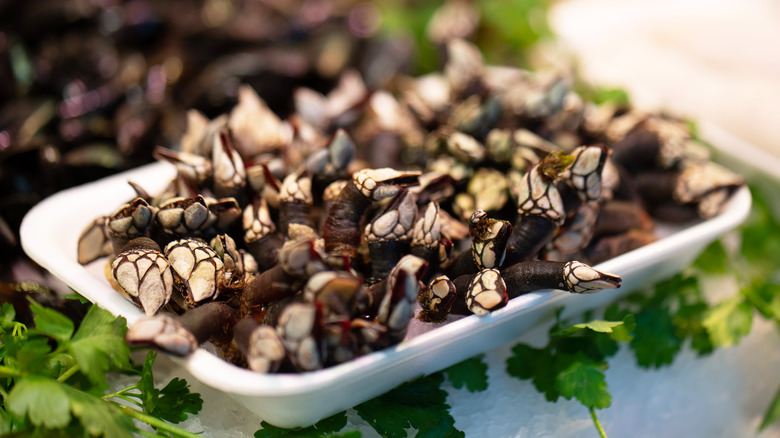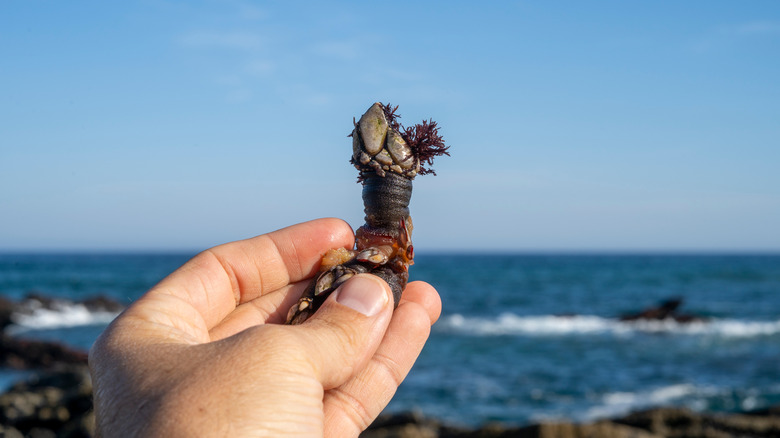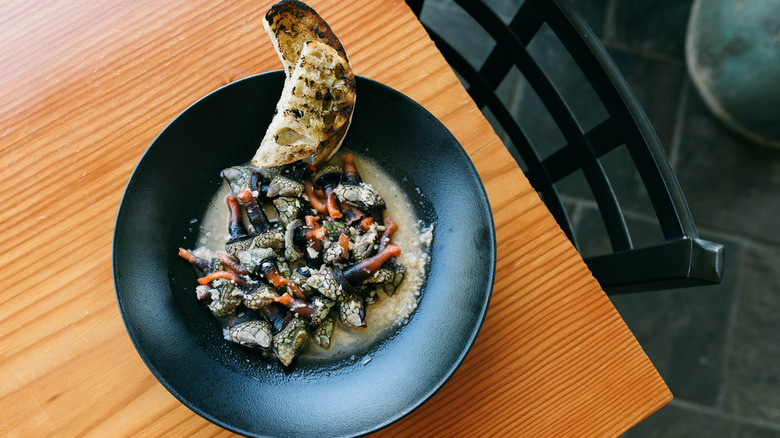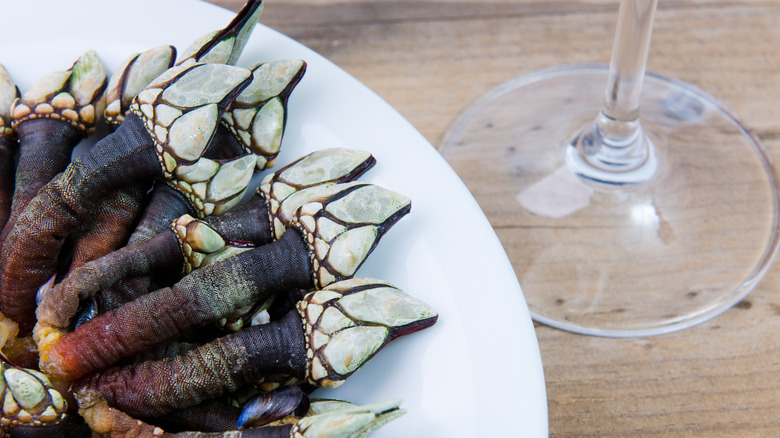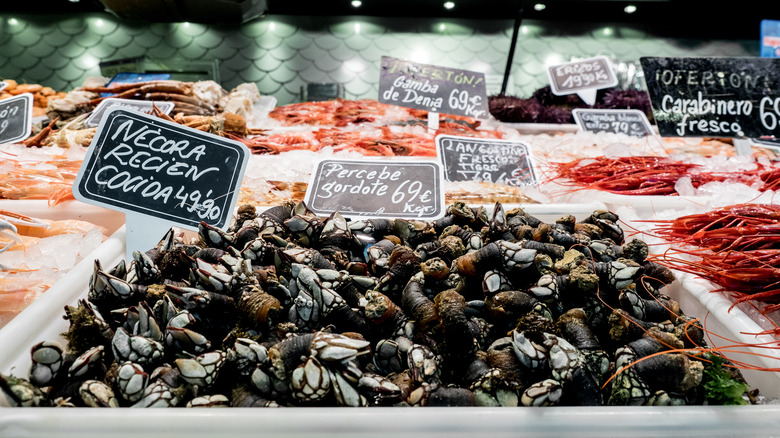What Are Gooseneck Barnacles And How Can You Eat Them?
With a sharp, claw-like shell and a long, neck-like stalk, anyone would be forgiven for thinking gooseneck barnacles are some kind of alien from outer space. But, in reality, gooseneck barnacles are a type of crustacean or shellfish that lives in the intertidal zones (the space between high and low tides) in the northeastern Atlantic ocean. They are considered a delicacy in some countries, including Spain.
When mature, gooseneck barnacles can grow to be about 3 inches long, and resemble the head and neck of a goose, thus giving them their namesake. They are often found attached to rocks and other hard surfaces along the seacoast, and can also be found on shipwrecks and driftwood. Their bodies are enveloped by a hard shell that is attached to a flexible muscular stalk, which uses cement glands to anchor themselves on surfaces where they feed by filtering food from seawater with their feathery feet (called cirri). They have a lifespan of up to 20 years.
The scientific name is Pollicipes pollicipes, although "gooseneck barnacle" can also apply to a similar (and also edible) species Pollicipes polymerus, found along the Pacific coast. Despite the fact that they are technically a different species, Pollicipes polymerus are considered identical when it comes to being used as food.
How are gooseneck barnacles harvested?
Unlike shellfish such as oyster, shrimp, and clams, gooseneck barnacles are not farmed through aquaculture. However, research has been conducted to determine its viability as a food crop. Instead, gooseneck barnacles are typically harvested by people that travel to coastal rocks; during times of low tide, when the barnacles are exposed, they are removed from the hard surfaces they cling to with specialized tools.
Since these creatures thrive in areas with frequent waves and changing tides, the harvest is determined by how long the barnacles can stay on the surface where they grow without getting swept off by water. Making the job more difficult is that the most prized specimens are often located in areas where the waves are particularly strong, since their stalks have to be stronger, and thus meatier, to withstand the surf.
It is a very difficult job to harvest gooseneck barnacles, and on average five people die during harvesting season in Spain, where barnacles are prolific. Gooseneck barnacles have also been long harvested by the First Nations for food along the west coast of Canada, and the Nuu-chah-nulth tribe currently operates the only commercial fishery for these barnacles. In U.S. states such as Washington and Oregon, there is a hard limit on the amount a person can harvest at any given time.
What do gooseneck barnacles taste like?
Gooseneck barnacles are eaten soon after harvest, as they degrade quickly after being sourcing, and freezing usually damages their meat. The only edible part of the barnacle is the meat located in the muscular stalk or "foot" of the barnacle, also known as the peduncle. Their taste has been described as similar to a very sweet razor clam, a mussel, or a cross between oysters and lobsters with fresh saltwater notes commonly found in shellfish. Texturally, they're described as crunchy at the initial bite, but the flesh becomes tender and dissolves in your mouth as you chew. They've also been described as having the texture of bivalves, such as clams and oysters.
The nutritional profile of gooseneck barnacles is as unique as they look. Water makes up 90% of the weight, with 100 grams of gooseneck barnacle meat containing 66 calories, nearly 16 grams of protein, and 0.4 grams of fat. It contains no carbohydrates.
Aside from being rich in protein and low in fat and carbs, barnacles also contain a host of minerals and vitamins that are considered beneficial to health, including potassium, iodine, selenium, magnesium, calcium, iron, and vitamins B1 and B2.
How do you cook gooseneck barnacles?
In Spain, where gooseneck barnacles are widely eaten as a delicacy (particularly during the Christmas season), the seafood is prepared by steaming briefly in seawater until the "skin" of the stalk can be removed cleanly from the meat. Consumers then pull the skin off the stalks and consume the meat within, often with a sprinkle of lemon juice or dipped in olive oil or an aioli. It's important not to overcook them, as they will become tough and chewy.
Although many enjoy these strange sea creatures without too much embellishment, you could add some additional flourish to maximize your enjoyment of this rare and expensive delicacy. Try tossing the barnacles with garlic butter for a very different take on shrimp scampi, or pair with wakame seaweed, soy sauce, and sesame oil for a Japanese-inspired treat. You could also add to a frutti di mare shrimp and squid salad for a Poseidon-worthy dish featuring the texture of different seafoods in a light lemon and olive oil dressing.
Where to buy gooseneck barnacles
Given the fact that gooseneck barnacles are difficult to harvest and have limited visual appeal, it's not surprising they're not widely available in local markets. Gooseneck barnacles are classified and graded on a scale from A to C, based on their shape and the amount of meat each barnacle holds. Firmer, meatier examples are graded higher and consequently are more expensive. As well, because they're a foraged item, their availability is dictated by the condition of the sea as well as the time of the year.
In Spain and Portugal, where they are a popular seafood pick, gooseneck barnacles can cost as much as $100 per pound. You can find vendors who sell them online; live specimens are sold starting at around $51 dollars per pound. When ordering gooseneck barnacles, bear in mind that 1.5 to 2 pounds would only yield about a half-pound of meat. Canned examples can be found online, usually preserved in brine and sold with shell-on for at least $33 dollars for a 4-ounce can.

